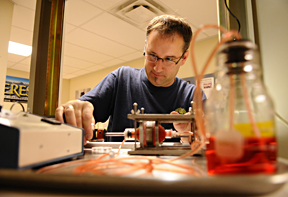Chipped a bone in a car accident? No problem. Ripped cartilage apart in your knee from years of running? That can be fixed, too. Blood vessels constricted by disease? Let’s make some new ones to replace them.
 |
| Erik Lizee, director of exhibit and media development at McWane Science Center, works on constructing part of UAB’s BioMatrix Engineering and Regenerative Medicine (BERM) Center exhibit. |
The BERM Center will display some of its innovative tools from Nov. 26 through Jan. 2, 2011, in McWane Science Center. In two bioreactors UAB scientists will grow blood vessels and cartilage using cells and biomaterial during the McWane exhibit “If a Starfish Can Grow a New Arm, Why Can’t I?”
Tissue engineering — or regenerative medicine — is an emerging multidisciplinary field involving biology, medicine and engineering, and it could be the next revolution in medicine, says Timothy Wick, Ph.D., co-director of the BERM Center and chair of UAB’s Department of Biomedical Engineering.
“The field of tissue engineering is exploding,” Wick says. “It is likely to revolutionize the ways we improve health and quality of life for millions of people by restoring, maintaining or enhancing tissue and organ function. It could be used to cure diseases and replace worn out body parts with living tissue-equivalents. It may enable us to cure and restore lost tissue function, rather than simply treat symptoms like pain with drugs or replacing lost tissue or organ function with things like metals, plastics and ceramics. It’s great to have an opportunity to share the effect this field can have on improving health and highlight the work of our researchers and students.”
Chandler Bibb, associate vice president of marketing for McWane, says UAB’s portion of the exhibit will be a highlight.
“After talking with Dr. Wick, our team was amazed by what they were working on,” Bibb says.
“We knew we had to find a way to help increase awareness in our community about their efforts. UAB graduate students also will be on the floor during the afternoons, explaining tissue engineering to visitors and showcasing UAB’s research.
“We want McWane Science Center visitors to hear researchers from UAB talk about tissue-engineering applications today and in the future and learn about careers in the field,” Bibb says.
“It’s a great opportunity for our students to teach science and engineering and interact with the local community,” Wick adds.
BERM Center strengths
The BERM Center is a collaborative alliance between the Department of Biomedical Engineering, Center for Metabolic Bone Disease, Cell Adhesion and Matrix Research Center and High-Resolution Imaging Facility.
The BERM Center capitalizes on UAB’s established strengths in matrix biology and emerging strengths in stem cell biology, 3-D cell and tissue culture, nano-structured biomaterials, tissue engineering and regenerative medicine.
Tissue engineering research involves several areas, including biomaterials, cell differentiation and cell-matrix interactions, biomolecules, engineering design, biomechanics, informatics to support tissue engineering and stem-cell research.
One BERM Center research project is trying to create a bone-graft substitute with adult stem cells that would give patients and physicians a safer, less expensive alternative to bone grafts.
Wick says replacement parts and therapies developed by tissue engineering are likely to come in waves in the future.
“When you think about tissue engineering going to market, it’s going to be product by product,” Wick says. “Some of the first products will be cartilage, skin, blood vessels, tendon, bone — tissues in the body that can be fairly easily replicated in the lab and function in the body when implanted. Replacing a kidney, liver or heart is farther down the road. We’ll need some technical breakthroughs there.”
Real-world perspectives
The “Starfish” traveling exhibit at McWane presents the basic sciences behind the complex topic of tissue engineering and provides real-world perspectives and applications. It offers young visitors (and their parents) a chance to discover the career opportunities possible in a wide range of fields — from applied science to government policy to design and engineering.
The exhibit also provides a bit more insight about the way humans are created, the effects of injury or disease, the process of healing and ways we might improve and enhance these processes.
“It’s a great introduction to the science of tissue engineering for visitors of all ages,” Bibb says. “There are several hands-on interactive areas that enable visitors to learn the basic biology of cells and test virtual experiments.”
Wick also will take part in a Science of Tomorrow luncheon scheduled for Dec. 10 from noon to 1 p.m. at McWane Science Center. Wick will discuss the science behind tissue engineering during the free event. RSVP for the luncheon by calling 714-8414 or e-mail reservations@mcwane.org.